
It was the first Saturday in October when I finally had an opportunity to return to the remarkable, large aspen stand I had discovered in the gorge of the River Cannich back in January. I’d been planning to go back there some time during the summer, but I hadn’t been able to fit a visit in, so this was my last chance now, before the trees lost their leaves for the winter. As it turned out, it was good timing, because to access the site requires a long walk through dense, tall bracken (Pteridium aquilinum), which would have been very difficult in the summer – now, in early October the bracken was all collapsing, and was somewhat easier to negotiate!

I began walking from where the road into Glen Cannich comes closest to the river, about a kilometre upstream from the gorge, and there are some smaller aspen stands beside the river there. They were at the peak of their autumn coloration, the leaves brilliant yellow-gold in colour, and all dancing together in the slightest breeze. Aspen (Populus tremula) is one of the first trees to lose its leaves in the autumn, so seeing these ones like this at the beginning of October was no surprise. Because it is also one of the last trees to get its new leaves each spring, aspen has a shorter growing season than any other tree in the Highlands.
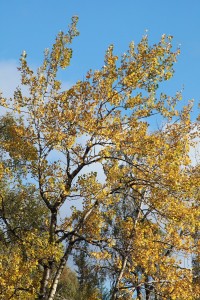
Autumn is the best time to spot aspens in the forest, as they stand out very clearly from the other trees due to their colour. When they are are their peak of yellow intensity, the birches are usually still mostly green – when they do turn yellow, the colour of the birches is more muted and less brilliant than that of the aspens.

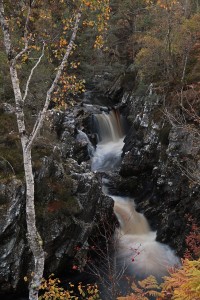
There’s an old foot bridge that gives access to the east side of the river there, so I crossed over it and headed downstream, towards the large aspen stand. Not far from the bridge, there are a couple of larger cascades on the river, with a special, wild quality to them.


Continuing downstream, I stopped to look at the decomposing log of a fallen birch tree, hoping to find either some interesting fungi, or possibly some slime moulds growing out of it. So far, it has been a poor year for fungi, with noticeably fewer fruiting bodies than normal appearing in September. However, after recent rain, some more had started to appear, so I was optimistic I’d see some at least this day.
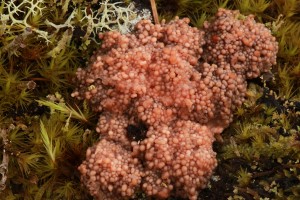
In fact, some bright orange-red blobs on the log drew my attention immediately, and I recognised them as being clusters of the sporangia, or fruiting bodies, of a distinctive slime mould (Tubifera ferruginosa). These had emerged from the log in amongst some Cladonia lichens, and one of the slime mould clusters completely surrounded one of the lichen podetia (cup-shaped fruiting bodies). A few inches away on the log, another cluster of the slime mould was at a more advanced stage of fruiting, and would probably release its spores within the next 24 hours.
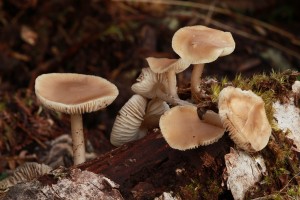
On another nearby birch log there was a cluster of fungi fruiting. I didn’t recognise these, so after photographing them I took a sample to send to Liz Holden, a mycologist who helps me with fungal identifications. A separate section of the same fallen birch tree nearby had a good example of the tinder fungus (Fomes fomentarius) fruiting on it. This is a hard, woody species that is common on dead birches and persists for a number of years.

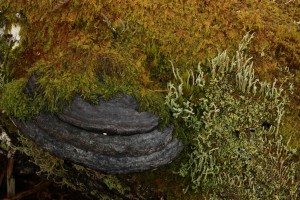
This particular tinder fungus was several years old, judging by the concentric growth patterns on it, and was partially overgrown with moss. Sometimes, the older fungi are completely covered by moss, where they occur in damp conditions.
By this time I was about 150 metres upstream from the large aspen stand, and I noticed what looked like some aspens on a rock outcrop on a bend in the river. I hadn’t seen these ones during my previous visit, because they had no leaves then, and I hadn’t followed the course of river around the bend at this location. Sure enough, there were several large aspen trees there, in a separate group to the main one further downstream. However, because of the location and the lighting (the sun was creating a lot bright patches and deep shadows as well) I wasn’t able to take any photographs of this stand.

Moving on downstream, I came to the edge of the large stand I’d found during my last visit, and was immediately impressed again by both the number of aspens growing together, and by how tall they are. These trees weren’t as advanced in their autumn coloration as those I’d seen at the start of the day, and had a mixture of green and slightly yellowing leaves.

This is a reflection of the fact that aspen stands are often made up of one or more clones, whereby what seem like separate trees are actually growing off the same root system underground, and are in fact single organisms with multiple trunks. Each group of such interconnected trunks is called a clone, and the individual trees in them will all come into leaf in spring, and change colour in the autumn, at the same time. Different clones have slightly different timings for these events, which is why some of the trees were more advanced in their autumn coloration than others. One of the trees in this large stand is very obviously larger than all the others, and I suspect it is the ‘parent tree’ from whose roots many of the others will have grown.
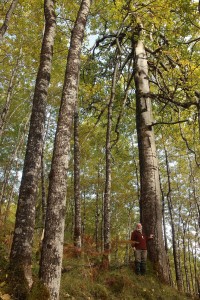
As I approached this tree, the words ‘clone mother’ came unbidden into my mind, and they seemed an apt monicker for this large, character-filled aspen. It was about twice the diameter of the other aspens around it, and had a large spreading canopy, indicating that it had grown in the absence of other trees nearby, although it was now surrounded by other aspens. They were obviously younger, having grown most likely from the roots of the larger tree at some point in the recent past when browsing pressure from red deer (Cervus elaphus) was reduced, therefore enabling them to escape being eaten. Aspen is one of the most palatable of all trees, along with rowan (Sorbus aucuparia), for animals such as deer, and usually the only place where young ones can grow is on rock outcrops or steep slopes that are inaccessible to ungulates.

It made my heart sing to be in amongst these aspens, especially given the knowledge that they had been here, unknown and undiscovered by anyone from Trees for Life, until I’d come across them in January. There are hundreds of separate trees in the stand altogether, and I made no attempt to count them on this day. That will have to wait for a formal survey that we’ll do of the stand, which is likely to be next year now.

The ‘clone mother’ tree is near the northern end of the stand, and I spent a while there, appreciating this special tree, and taking some more photographs. While doing so, I noticed some groups of a fungus amongst the trees that I’ve seen with aspens before. I think they are a species in the Bolete family called Leccinium aurantiacum, but I’ll have to get that confirmed. With their chestnut-coloured caps and thick stems, they are quite beautiful to look at, and are obviously attractive to slugs, as one of them had obvious signs of mollusc feeding on its stem.

Nearby, on a fallen birch tree, there was a bright yellow-orange fungus growing horizontally out of the log. This was a honey fungus (Armillaria sp.), but as there are several closely related species, I’ll have to rely on Liz’s expert opinion to confirm which one it is. Normally the fruiting bodies of the honey fungus occur in clusters together, so it was unusual to see just this single one fruiting on the log. It hadn’t opened its cap fully yet, so perhaps it was the forerunner of more that would appear there in the coming days.

Moving further into the stand, the trees became denser, and the straight, parallel trunks provided the opportunity for some interesting photographs. Some of the trunks had a pale greenish colour, and this indicates the presence of chlorophyll in them. In fact, aspen is noted for its ability to photosynthesise in winter, using the chlorophyll in its trunk, and I sometimes wonder if this ability has developed to compensate for the relatively short time it has leaves each year, which restricts its opportunity to photosynthesise by more conventional means.


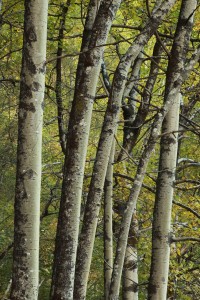


As I was photographing these aspens, I noticed something small, bright and colourful on the sleeve of my jacket. Looking closely, I saw that it was a ladybird, but one with different coloration from others I’ve seen before, so I didn’t immediately know which species it was. It must have come off one of the aspens, where I suspect it had been feeding on aphids, so I put it on a fallen aspen leaf, to photograph it. Later, I was able to identify it easily from a specialist ladybird website as being the cream-spot ladybird (Calvia 14-guttata), a species which occurs on a variety of deciduous trees and shrubs.
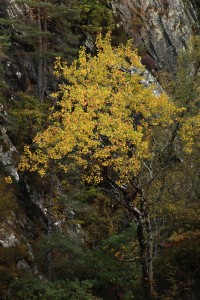
At the same place, while I was looking around, my attention was drawn by some brilliant yellow foliage on the other side of the river. Finding a gap in the trees where I was standing, I was able to get a clear view of what were several aspen trees, growing on the other side of the gorge – it was another aspen stand that I hadn’t seen on my previous visit in January!

There were several aspens just across the gorge from me, and I could see some more in the distance, further downstream as well. The gorge is too steep on the side I was on for me to go any further downstream, to see how many there were across the river there. I’ll have to make another trip to that western side of the gorge in future, to explore the extent of the aspens there.
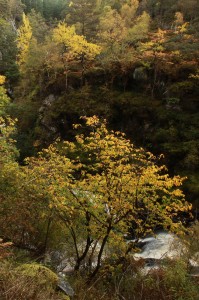
It’s not just aspens that are growing in the gorge either. On my previous visit in January I’d seen some oaks (Quercus petraea) and this time I spotted a wych elm (Ulmus glabra) as well.


By this time it was quite late in the afternoon, so it was time to head back to my car, and I still hadn’t fully explored this large aspen stand (never mind the two others I’d discovered on this trip!). On my way, I stopped again by the ‘clone mother’ tree, appreciating both that tree and all the progeny it had produced around itself.


It had been another great day, but I’ll have to return again to continue my explorations of these wonderful aspen stands in the River Cannich gorge. In the meantime, I’ll finish here with a compilation of some video footage I shot during the day:
[jwplayer config=”alan29may” file=”http://www.alansblog.org.uk/alan-oct-12.mov” html5_file=”http://www.alansblog.org.uk/alan-oct-12.mov” image=”http://www.alansblog.org.uk/alan12oct.jpg”]
Thanks for the blog Alan,
Whilst I am stuck in the rain, in the dark, in traffic, in Manchester it’s good to have a legman bringing me the latest from big beautiful wide world. Keep them coming.
Phil mason
Hi Phil, Thanks for your comment, and I’m pleased that my blogs provide inspiration to you in urban traffic jams! Yes, they will keep on coming indeed – I’m just working on another blog now, and hope to get it posted later this evening. With best wishes, Alan.